Friday Jan 17, 2025
Friday Jan 17, 2025
Monday, 4 January 2021 00:00 - - {{hitsCtrl.values.hits}}
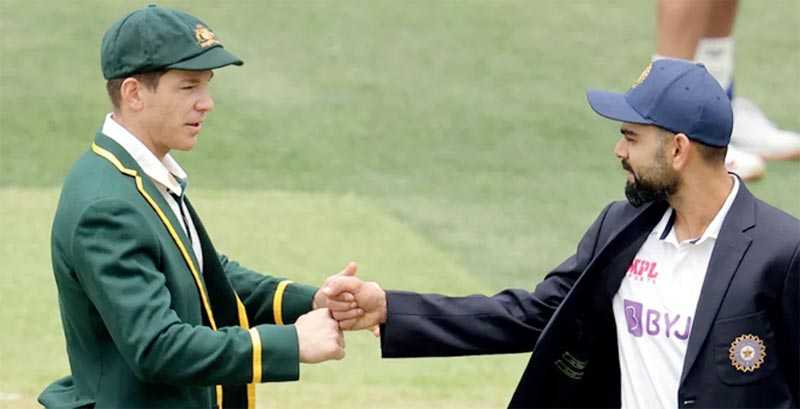
Lose toss, win match; that's just how 2020 rolls
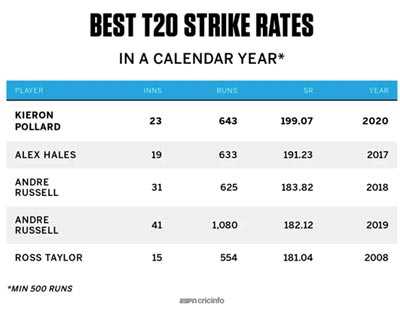 |
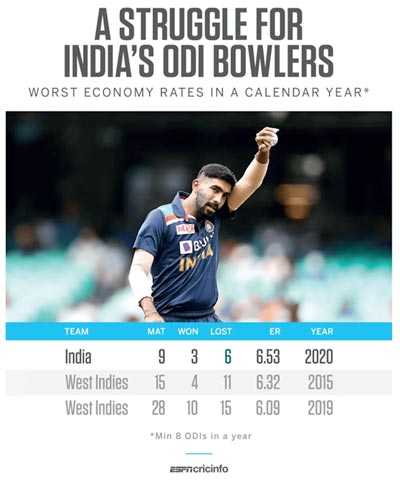 |
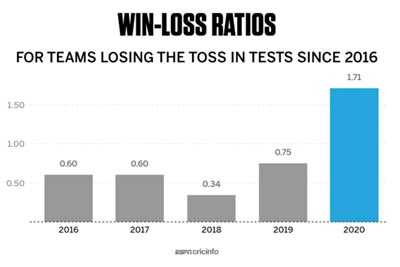 |
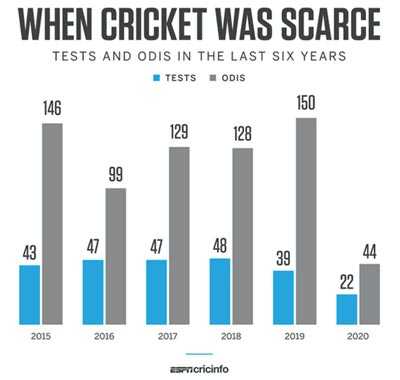 |
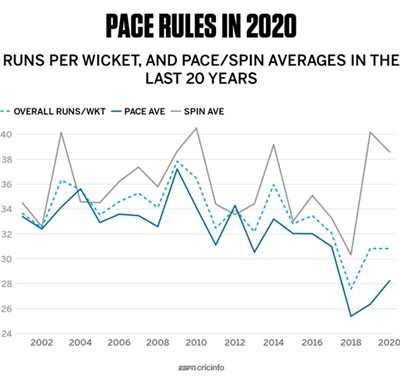 |
 |
ESPNCricinfo: In a year that was nothing like we have ever seen before, sports schedules were impacted severely, and cricket was no different. Only 22 Tests and 44 ODIs were played in a year affected badly by the pandemic; the last time fewer matches were played in each format was in 1991, which had 21 Tests and 39 ODIs. Compared to 2019, there was a 44% drop in Tests, and a 71% in ODIs. (The ODI drop was more pronounced because 2019 was a World Cup year.) The 95 T20Is in 2020 was less than a third of the 307 such matches played the previous year.
With a series against Bangladesh and a Test against Afghanistan getting cancelled, Australia ended up playing just three Tests in the year, the fewest for them in a calendar year since 1962, when they played two. There were only two Test matches played in Asia – one in Pakistan and one in Bangladesh – making it the first time since 1991 that Asia hosted fewer than three Tests.
With the number of matches being so heavily curtailed, obviously none of the records for most runs/wickets in a calendar year were threatened in 2020. No batsman came within touching distance of 1000 Test runs – the nearest was Ben Stokes with 641. In fact the top five run-getters were all from England, thanks largely to the fact that they were involved in 41% of the total Tests played in the year – nine out of 22. None of the other teams played more than six. It wasn’t surprising, therefore, that the top wicket-taker was from England either – Stuart Broad with 38. Similarly, Australia were the only team to play ten ODIs in the year, and they dominated the list of top run-scorers and wicket-takers in the format.
Fast bowlers rule, batsmen struggle
While the number of matches were fewer, what didn’t change was the recent trend of batsmen struggling and fast bowlers dominating in Test matches. The last three years have produced the lowest annual runs-per-wicket number in the last 20 years – it was 27.58 in 2018, and 30.83 in each of the last two years. That is a huge drop compared to the numbers we used to see around ten years back: in 2009 the average runs per wicket was 37.84, and in 2010, 36.48.
For the third year in succession, fast bowlers conceded fewer than 30 runs per wicket - they averaged 25.39 in 2018, 26.36 in 2019, and 28.24 in 2020. Again, it is a huge drop from the numbers we used to see at various points in the last 20 years: the pace average in 2009 was 37.22, and in 2004 it was 35.63. The top seven Test wicket-takers of 2020 were all fast bowlers, and six of them conceded fewer than 22 runs per wicket, with two of them averaging less than 15. It wasn’t such a good year for spin - they averaged 38.59 - but that is understandable as only two out of 22 Tests were played in Asia. (Spin fans did have something to celebrate, though: Sikandar Raza’s 7 for 113 topped the charts for best bowling display in an innings. The only other time a Zimbabwean topped this list was in 2000, when Paul Strang took 8 for 109 against New Zealand.)
With fast bowlers so dominant, these are obviously not fun times for opening batsmen. They averaged 30.85 in 2020, the second-lowest in the last 20 years. Only three openers scored centuries last year: Dom Sibley, Shan Masood (two each) and David Warner. The average opening stand has been less than 32 in each of the last three years, while it happened only once in the previous 17.
Ben Stokes’ phenomenal year
It was a tough year for Stokes on the personal front, but on the cricket field he was in phenomenal form with both bat and ball. He played seven of England’s nine Tests in 2020 – missing two games against Pakistan to be with his ailing father – and he put in impactful performances in almost each of those matches.
That he topped the Test aggregate for the year illustrates just how good he was with the bat - his 641 runs came at an average of 58.27, and included two hundreds. With ball in hand, he took 19 wickets at 18.73. That puts him in an extremely select list of players who have averaged 50-plus with the bat and sub-20 with the ball in a calendar year (with a cut-off of 500 runs and 15 wickets). There have only been two other such instances: by Mushtaq Mohammad in 1973, and by Steve Waugh in 1994.
Waugh might look like a rather unlikely candidate to be on this list, given that he was an occasional bowler, but he had an impressive year with the ball, taking ten wickets in three Tests in South Africa, including a career-best haul of 5 for 28. Mushtaq took eight wickets from two Tests in New Zealand at an average of 11.25, and followed that with 12 from three home Tests against England. With bat he was even more prolific, scoring three hundreds and four fifties in ten innings.
When losing the toss didn’t matter
Given that 2020 was such a topsy-turvy year, it is perhaps fitting that the toss results defied conventional logic too. All three Boxing Day Tests were won by the team that lost the toss, taking the win-loss record in Tests for teams losing the toss to 12-7, which is a win-loss ratio of 1.714. The last time teams losing the toss had a better ratio was in 2010, when they won 21 Tests and lost only 11, a ratio of 1.909.
The sample size was small in 2020, and there were instances when the stronger team lost the toss - like Bangladesh against Zimbabwe, or England and New Zealand against West Indies - but it was still a drastic departure from the trends we had seen over the previous four years: in the period between 2016 and 2019, teams losing the toss had a 56-102 win-loss record, and a dismal ratio of 0.549.
India’s forgettable year in ODIs
India finished the year on a high with a fantastic Test victory against Australia, after losing the three other Tests they played in the year, but their ODI numbers were quite unflattering: three wins and six defeats in nine games. The last time India had a poorer win-loss ratio in a calendar year was way back in 1997, when they won ten games and lost 23. In the three previous years (2017 to 2019), India had a phenomenal ODI record, winning 54 and losing only 19. That win-loss ratio was better than all the top teams except England.
India’s major concern in ODIs was their bowling: they conceded 300 or more five times in nine games, including back-to-back scores of 389 and 374 against Australia in Sydney, and leaked 6.53 runs per over. That is the worst economy rate in a calendar year for any team that played eight or more games; that record was previously held by West Indies, who conceded 6.32 runs per over from 15 games in 2015.
Ravindra Jadeja’s economy rate of 5.36 was the best among all India bowlers, followed by Jasprit Bumrah’s 5.62 (though he took only five wickets at a cost of 482 runs). Mohammed Shami, Shardul Thakur and Navdeep Saini went at more than seven an over, while Yuzvendra Chahal and Kuldeep Yadav conceded more than 6.4 per over.
Pollard’s stunning T20 form
Kieron Pollard’s batting prowess in T20s has been well established for several years now - he is one of only three batsmen with 10,000-plus runs in this format - but in 2020 he took his batting to an altogether new level.
Pollard played two T20 leagues last year - the CPL and the IPL. In the CPL, he scored 207 runs at an average of 51.75 and a strike rate of 204.95. In the IPL, he scored 268 runs at 53.60 and a strike rate of 191.42. In his four T20I innings, he scored 168 runs at 56 and a strike rate of 204.88. That gave him an aggregate of 643 runs for the year, at an average of 53.58, and a strike rate of 199.07.
Early in the year, he became the second player - after Chris Gayle - to reach 10,000 T20 runs; through the rest of the year, he underlined why he is among the most feared batsmen in this format. The average was a function of not-outs - he was unbeaten in 11 out of 23 innings - but there were no asterisks with the strike rate, where he was well clear of anyone else. With a cut-off of 500 runs, the next best was Andre Russell’s 167.31.
In fact, among all the instances of batsmen who have scored 500-plus runs in a calendar year - there are 776 such occurrences - Pollard’s strike rate of 199.07 is the best. That’s how good Pollard the batsman was in T20 cricket in 2020.
